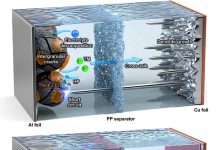
A safer, cheaper, and more environmentally friendly battery may soon be possible thanks to new research from the University of Adelaide.
Scientists there have developed a “dual-salt electrolyte” that allows water-based zinc batteries to keep 93% of their capacity even after 900 charging cycles.
The discovery could pave the way for greener batteries to power cars and stabilize electricity grids.
Right now, lithium-ion batteries dominate the market for electric vehicles and renewable energy storage.
But lithium has serious downsides: limited supply, high cost, and environmental concerns related to mining and recycling. Zinc, on the other hand, is abundant, low-cost, and less harmful to the planet.
Zinc batteries—also called aqueous zinc batteries (AZBs)—use water mixed with zinc salts as the liquid electrolyte, and zinc metal as the anode.
Because the liquid is water-based, the batteries are not flammable, making them far safer than lithium-ion versions.
They also pack a lot of energy into a small space.
Despite these advantages, zinc batteries haven’t been practical because of technical problems. When the zinc reacts with the electrolyte, it can corrode and release hydrogen gas, which shortens the battery’s life and limits its ability to work in extreme temperatures.
The Adelaide team, led by Professor Zaiping Guo, has found a clever solution. Their new electrolyte contains two types of zinc salts that work together but stay in separate zones.
One salt—zinc perchlorate—remains in the liquid, helping the battery handle freezing conditions and speeding up how ions move, which improves charging speed. The other—zinc sulfate—forms a protective layer on the zinc metal, preventing corrosion and damage.
“This is like giving each salt its own job,” explained first author Guanjie Li. “One manages temperature and charging, the other protects the metal. Together they make the battery much more reliable.”
Tests show that the batteries using this dual-salt system can operate in temperatures as low as -40°C and as high as +40°C, while still maintaining excellent performance. “This is the first time we’ve seen such a well-balanced result in our field,” said co-author Dr. Shilin Zhang.
Importantly, the design keeps the benefits of water-based systems: the electrolyte is non-flammable, affordable, and sustainable. Unlike other approaches that rely on high-concentration chemicals or hybrid liquids, this dual-salt method keeps things simple while greatly improving durability.
The team is now working on refining the electrolyte recipe and testing it in real-world battery prototypes. Their goal is to create long-lasting, high-energy, low-cost batteries that could help nations move toward safer and more sustainable energy storage solutions.
If successful, these zinc batteries could one day replace lithium-ion systems in electric vehicles and smart power grids—delivering cleaner energy with fewer risks.



